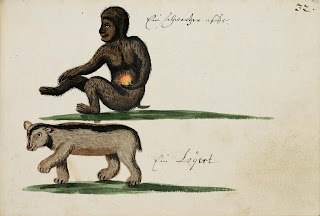









A selection from their photographic archives. Link…
A collection of things I find that interest me.






We have about made up our minds to return to camp, when a steady splash! splash! is heard, as of some large animal walking in the water. Our ears catch the direction, and we look, eagerly expecting the animal to come in sight around the bend of the stream. The splashing continues, and, to our surprise, an enormous bull moose comes in sight, the water dripping from his ill-shaped nose and mouth, and a long piece of pond-lily root dangling down, upon one end of which he is chewing. As the animal comes in sight he stops, pricks up his ears, and looks intently in our direction. As the wind is drawing slowly toward the animal, we do not hesitate to shoot. We draw the sights low down on his shoulder and press the trigger. As the reports of the smooth bore and rifle ring out simultaneously, the bull makes a great leap and disappears into the bushes that fringe the stream. We hasten to the spot and find the tracks in the soft moss. We follow them for a short distance and are finally rewarded by a sight of blood upon the leaves. As we proceed, the trail of blood is more easily followed, and here, where the poor beast stood still for a short time, there is quite a pool of clotted blood. Evidently the animal is badly hurt, and we resolve to return to the canoe and skin our beaver, and leave the moose to succumb to his wounds, rather than to follow too hastily and again start him while he has sufficient strength to run. …The art of taxidermy, by John Rowley. Link…
There is the spot where we stopped following the tracks and trail of blood. Although the moss has fluffed out some in the tracks, and as a consequence these are not so distinct as at first, still, with the aid of the blood spots, we have no difficulty in keeping on the right track. Here is a spot where the moose lay down to rest for a time, until the pain from the wounds became too severe. And see this great pool of clotted blood in the centre of the bed! See where he crashed through that pile of brus.h instead of going around it! The spots of blood on the trail are now less and less frequent, the blood having probably clotted and dried over the wound and prevented its flow. As we continue to follow on the trail a strange odour suddenly smites our nostrils, and we at once know that we are close to the animal. Bull moose at this season have a strong odour, and if the wind is right this may be detected for quite a distance. We now proceed cautiously, with guns cocked and ready, expecting the moose to jump at every step. There he lies beside that moss-covered log. A closer inspection assures us that another shot is unnecessary, as the beast lies prone upon his side, dead.
As the fact dawns upon us that this huge beast is really ours, the forest echoes with our yells of delight. And what a mighty pair of antlers!—and all secured through the blindest luck.
We sit down upon a log and congratulate ourselves upon our phenomenal luck.












